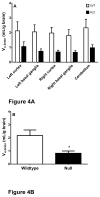Influence of peptide transporter 2 (PEPT2) on the distribution of cefadroxil in mouse brain: A microdialysis study
- PMID: 28192085
- PMCID: PMC5365381
- DOI: 10.1016/j.bcp.2017.02.005
Influence of peptide transporter 2 (PEPT2) on the distribution of cefadroxil in mouse brain: A microdialysis study
Abstract
Peptide transporter 2 (PEPT2) is a high-affinity low-capacity transporter belonging to the proton-coupled oligopeptide transporter family. Although many aspects of PEPT2 structure-function are known, including its localization in choroid plexus and neurons, its regional activity in brain, especially extracellular fluid (ECF), is uncertain. In this study, the pharmacokinetics and regional brain distribution of cefadroxil, a β-lactam antibiotic and PEPT2 substrate, were investigated in wildtype and Pept2 null mice using in vivo intracerebral microdialysis. Cefadroxil was infused intravenously over 4h at 0.15mg/min/kg, and samples obtained from plasma, brain ECF, cerebrospinal fluid (CSF) and brain tissue. A permeability-surface area experiment was also performed in which 0.15mg/min/kg cefadroxil was infused intravenously for 10min, and samples obtained from plasma and brain tissues. Our results showed that PEPT2 ablation significantly increased the brain ECF and CSF levels of cefadroxil (2- to 2.5-fold). In contrast, there were no significant differences between wildtype and Pept2 null mice in the amount of cefadroxil in brain cells. The unbound volume of distribution of cefadroxil in brain was 60% lower in Pept2 null mice indicating an uptake function for PEPT2 in brain cells. Finally, PEPT2 did not affect the influx clearance of cefadroxil, thereby, ruling out differences between the two genotypes in drug entry across the blood-brain barriers. These findings demonstrate, for the first time, the impact of PEPT2 on brain ECF as well as the known role of PEPT2 in removing peptide-like drugs, such as cefadroxil, from the CSF to blood.
Keywords: Blood-cerebrospinal fluid barrier; Brain extracellular fluid; Cefadroxil; Microdialysis; Peptide transporter 2.
Copyright © 2017 Elsevier Inc. All rights reserved.
Conflict of interest statement
Note: The authors declare no competing financial interest.
Figures






Similar articles
-
Impact of genetic knockout of PEPT2 on cefadroxil pharmacokinetics, renal tubular reabsorption, and brain penetration in mice.Drug Metab Dispos. 2007 Jul;35(7):1209-16. doi: 10.1124/dmd.107.015263. Epub 2007 Apr 23. Drug Metab Dispos. 2007. PMID: 17452417
-
Effect of transporter inhibition on the distribution of cefadroxil in rat brain.Fluids Barriers CNS. 2014 Nov 14;11(1):25. doi: 10.1186/2045-8118-11-25. eCollection 2014. Fluids Barriers CNS. 2014. PMID: 25414790 Free PMC article.
-
PEPT2 (Slc15a2)-mediated unidirectional transport of cefadroxil from cerebrospinal fluid into choroid plexus.J Pharmacol Exp Ther. 2005 Dec;315(3):1101-8. doi: 10.1124/jpet.105.090654. Epub 2005 Aug 17. J Pharmacol Exp Ther. 2005. PMID: 16107517
-
Role and relevance of PEPT2 in drug disposition, dynamics, and toxicity.Drug Metab Pharmacokinet. 2008;23(4):236-42. doi: 10.2133/dmpk.23.236. Drug Metab Pharmacokinet. 2008. PMID: 18762710 Free PMC article. Review.
-
Substrates of the human oligopeptide transporter hPEPT2.Biosci Trends. 2015 Aug;9(4):207-13. doi: 10.5582/bst.2015.01078. Biosci Trends. 2015. PMID: 26355221 Review.
Cited by
-
Higher Brain Uptake of Gentamicin and Ceftazidime under Isoflurane Anesthesia Compared to Ketamine/Xylazine.Pharmaceutics. 2024 Jan 19;16(1):135. doi: 10.3390/pharmaceutics16010135. Pharmaceutics. 2024. PMID: 38276505 Free PMC article.
-
Advances in Intrathecal Nanoparticle Delivery: Targeting the Blood-Cerebrospinal Fluid Barrier for Enhanced CNS Drug Delivery.Pharmaceuticals (Basel). 2024 Aug 15;17(8):1070. doi: 10.3390/ph17081070. Pharmaceuticals (Basel). 2024. PMID: 39204177 Free PMC article. Review.
-
Biology of Peptide Transporter 2 in Mammals: New Insights into Its Function, Structure and Regulation.Cells. 2022 Sep 14;11(18):2874. doi: 10.3390/cells11182874. Cells. 2022. PMID: 36139448 Free PMC article. Review.
-
Proton-Coupled Oligopeptide Transport (Slc15) in the Brain: Past and Future Research.Pharm Res. 2023 Nov;40(11):2533-2540. doi: 10.1007/s11095-023-03550-9. Epub 2023 Jun 12. Pharm Res. 2023. PMID: 37308743 Review.
-
Structural snapshots of human PepT1 and PepT2 reveal mechanistic insights into substrate and drug transport across epithelial membranes.Sci Adv. 2021 Nov 5;7(45):eabk3259. doi: 10.1126/sciadv.abk3259. Epub 2021 Nov 3. Sci Adv. 2021. PMID: 34730990 Free PMC article.
References
-
- Liu W, Liang R, Ramamoorthy S, Fei YJ, Ganapathy ME, Hediger MA, Ganapathy V, Leibach FH. Molecular cloning of PEPT 2, a new member of the H+/peptide cotransporter family, from human kidney. Biochim Biophys Acta. 1995;1235(2):461–6. - PubMed
-
- Daniel H, Kottra G. The proton oligopeptide cotransporter family SLC15 in physiology and pharmacology. Pflugers Arch. 2004;447(5):610–8. - PubMed
-
- Ocheltree SM, Shen H, Hu Y, Keep RF, Smith DE. Role and relevance of peptide transporter 2 (PEPT2) in the kidney and choroid plexus: in vivo studies with glycylsarcosine in wild-type and PEPT2 knockout mice. J Pharmacol Exp Ther. 2005;315(1):240–7. - PubMed
-
- Shu C, Shen H, Teuscher NS, Lorenzi PJ, Keep RF, Smith DE. Role of PEPT2 in peptide/mimetic trafficking at the blood-cerebrospinal fluid barrier: studies in rat choroid plexus epithelial cells in primary culture. J Pharmacol Exp Ther. 2002;301(3):820–9. - PubMed
Publication types
MeSH terms
Substances
Grants and funding
LinkOut - more resources
Full Text Sources
Other Literature Sources
Medical
Molecular Biology Databases

